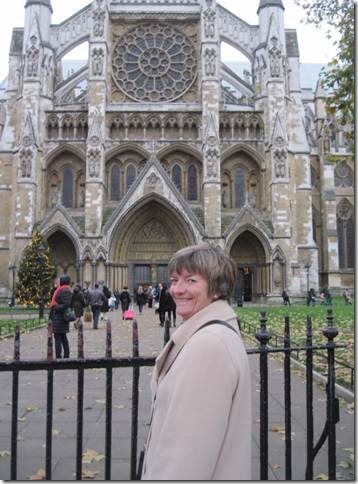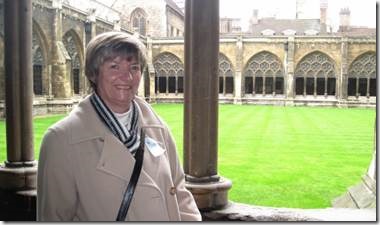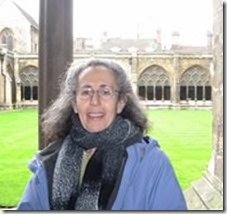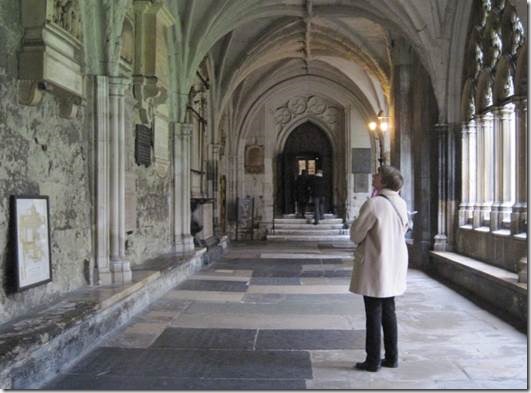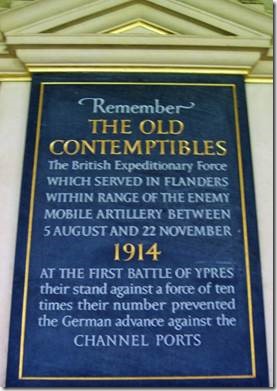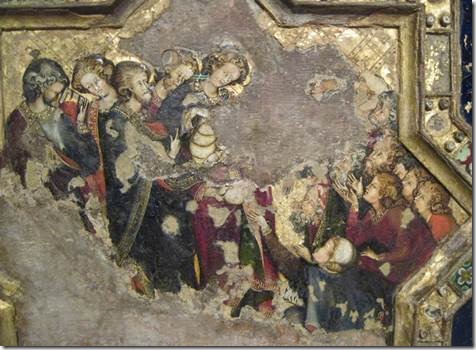Cheers,
So are you all racing around like mad getting ready for Christmas? On Monday or Tuesday Randal, Singkey and I will go look at the windows of Harrods and Selfridges which are famous for their decorations. On Christmas Day cruisers Sandi and Colin have invited all the rest of us to join in on one of their Christmas traditions; a walk to a nearby pub for a glass of cheer. We’ll meet at 11:45 am and then walk together to the Captain Kidd Pub.
Last night Singkey cooked a wonderful soup with potatoes, dried mushrooms, dried dates, ginger, a bit of sugar and chicken wings. I had two bowls. The broth alone was wonderful. I’ll have to watch her next time so I can learn to make it too.
This afternoon I’m off to my life drawing class. I’m probably not getting any better, but I’m not getting any worse.
I’m afraid that this email again has many more words than photos; no camera’s allowed in most of Westminster Abbey. It was a fascinating tour with a lovely guide and Valerie and I enjoyed it immensely. By the time we left, I think we were both ready for a nap. But alas, Valerie had to catch the train back to Fleet before rush hour so she could have an off-peak fare and more importantly get a seat!
Between visiting St Paul’s Cathedral and Westminster Abbey I’ve learned a bit of British History. As it includes mention of other parts of Great Britain I can use the word British rather than English. I have only recently learned that British and English are definitely not the same.
“Westminster Abbey is steeped in more than a thousand years of history. Benedictine monks first came to this site in the middle of the tenth century, establishing a tradition of daily worship which continues to this day.
The Abbey has been the coronation church since 1066 and is the final resting place of seventeen monarchs. (The fact that it was the coronation protected it at times during its history.)
The present church, begun by Henry III in 1245, is one of the most important Gothic buildings in the country, with the medieval shrine of an Anglo-Saxon saint still at its heart.
A treasure house of paintings, stained glass, pavements, textiles and other artefacts, Westminster Abbey is also the place where some of the most significant people in the nation’s history are buried or commemorated. Taken as a whole the tombs and memorials comprise the most significant single collection of monumental sculpture anywhere in the United Kingdom.
The Library and Muniment Room houses the important (and growing) collections of archives, printed books and manuscripts belonging to the Dean and Chapter of Westminster, providing a centre for their study and for research into all aspects of the Abbey’s long and varied history.
http://www.westminster-abbey.org/
My favorite part was Poet’s Corner http://www.westminster-abbey.org/ because, here, more than any other place in London, I recognize names. Actually, I think the day we visited I was more familiar with Edward Bulwer Lytton than our very knowledgeable tour guide or the lovely visiting Canadian priest. Lytton is buried in Westminster Abbey, but not in Poet’s Corner and that’s a very interesting story itself.
“It was a dark and stormy night.” Remember that line? It was originally written by Edward Bulwer-Lytton.
“The Dean of Westminster was at first reluctant to give consent to Lytton’s burial in Westminster Abbey but John Forster, a friend of Dickens, urged Dean Stanley to allow it saying that if a man like Lord Lytton was not buried in the Abbey, he could not see on what ground anyone else should be included. After a letter appeared in The Times also supporting the burial, the Dean consented, but decided that he should be buried not in Poets’ Corner but in St Edmund’s chapel to be near Sir Humphrey Bourgchier, a knight who was killed at the battle of Barnet and who appeared in one of Lytton’s romances.”
http://www.westminster-abbey.org/our-history/people/edward-bulwer-lytton
‘Literary tragedy’ of Bulwer-Lytton’s dark and stormy night under debate
Alison Flood
theguardian.com, Tuesday 19 August 2008 15.08 BST
The great-great-great grandson of the much-maligned author Sir Edward Bulwer-Lytton is to take part in a debate to defend his ancestor’s writing. The Honourable Henry Lytton Cobbold, of Knebworth House in Hertfordshire, is travelling to Bulwer-Lytton’s namesake, the town of Lytton in Canada, to take on the founder of the International Bulwer-Lytton Fiction Contest, Professor Scott Rice.
Bulwer-Lytton has been ridiculed by the contest since 1982, when Rice came up with the idea for a competition to compose the opening sentence to the worst possible novel, inspired by Bulwer-Lytton’s notorious "It was a dark and stormy night". The Great Bulwer Lytton Debate will take place in Lytton, British Columbia on August 30, and will see Scott attempt to show why the opening line is a "literary tragedy".
"I come to bury Lytton, not to praise him," said Rice. "The evil that men do lives after them, in Lytton’s case in 27 novels whose perfervid turgidity I intend to expose, denude, and generally make visible."
"I’m off to defend his honour," Lytton Cobbold said. "Bulwer-Lytton was a remarkable man and it’s rather unfair that Professor Rice decided to name the competition after him for entirely the wrong reasons. He was a great champion of the arts, and made such a huge difference to people in all walks of life…he was politician, writer, playwright and philosopher.
Defending Bulwer-Lytton’s "dark and stormy night", Lytton Cobbold said he believed that "to have been the first person to have penned a cliché was a mark of genius". He said that Bulwer-Lytton invented a raft of sayings we still use today, including "the pen is mightier than the sword", "the great unwashed" and "the almighty dollar".
"He also left us Knebworth House, which is no bad thing," he added. "And I think the community in the town of Lytton is going to be more inclined to support me [than Scott]; Bulwer-Lytton made them quite happy – it’s partly because of him that they didn’t end up being part of America."
In a letter yesterday to Canada’s Globe and Mail, Lytton’s mayor Chris O’Connor said the town of Lytton had had enough. "For years, Professor Rice has been making sport of Lord Edward George Bulwer Lytton, with his Bulwer-Lytton Fiction Contest. Lord Lytton was both a statesman and an author. As colonial secretary, he helped create the Crown Colony of British Columbia in 1858."
O’Connor said he expected Lytton to be vindicated in the debate. "As he wrote, ‘One of the sublimest things in the world is the plain truth’," he said, adding: "It won’t be a ‘dark and stormy night’; the debate is at 3pm."
The truncated version of the first line of Bulwer-Lytton’s 1830 novel Paul Clifford does not, perhaps, do justice to the full glory of the entire line: "It was a dark and stormy night; the rain fell in torrents – except at occasional intervals, when it was checked by a violent gust of wind which swept up the streets (for it is in London that our scene lies), rattling along the housetops, and fiercely agitating the scanty flame of the lamps that struggled against the darkness."
This year’s contest was won last week by 41-year-old communications director Garrison Spik, from Washington DC, for the line: "Theirs was a New York love, a checkered taxi ride burning rubber, and like the city their passion was open 24/7, steam rising from their bodies like slick streets exhaling warm, moist, white breath through manhole covers stamped ‘Forged by DeLaney Bros., Piscataway, NJ.’"
http://www.theguardian.com/culture/2008/aug/19/2
http://www.bulwer-lytton.com/ is the site for the contest
|
The north transept and rose window…and Valerie “The great door of the northern transept is an arch sprung from four large pillars on either side, with foliated capitals. The wall is of considerable thickness, and on each side of the great door it is formed into two arches by handsome pillars; the lesser entrances to the aisles are four pillars in depth, with ribbed roofs, having figures of angels at the intersections of the ribs. Above the doorways is a colonnade or range of pierced arches. Four massive buttresses secure the front; those at the angles terminate in octagons, and are connected with the upper part of the walls, over the side-aisles, by strong arches. Between the colonnade and the point of the roof is a beautiful "rose window," which was rebuilt in the year 1722. A great part of the north transept was rebuilt in 1828. "Time was," writes Mr. Charles Knight, "when this front had its statues of the twelve apostles at full length, and a vast number of other saints and martyrs, intermixed with intaglios, devices, and abundance of fretwork; and when, on account of its extreme beauty, it was called ‘Solomon’s Porch;’ and now, even injured as it is, the whole forms a rich and beautiful façade." http://www.british-history.ac.uk/ |
|
Here we are in the Cloister…I think |
|
The west cloister… I think |
|
Old Contemptibles, British Expeditionary Force In the west cloister of Westminster Abbey is a memorial to the "Old Contemptibles", or British Expeditionary Force 1914. The mural monument, of limestone and Welsh blue slate, was designed by Donald Buttress, and shows the badge of the Old Contemptibles Association at the base. The inscription,with some gilded letters, reads: "Remember THE OLD CONTEMPTIBLES The British Expeditionary Force which served in Flanders within range of the enemy mobile artillery between 5 August and 22 November 1914. At the first battle of Ypres their stand against a force of ten times their number prevented the German advance against the Channel ports. Unveiled 15 July 1993 by H.M. Queen Elizabeth The Queen Mother". The B.E.F. of 1914 consisted of a cavalry division and several infantry divisions. Its commander was Field Marshal Sir John French. The troops of the Force were later joined by re-inforcements from Canada and India. The first battle was at Mons on 23 August 1914, from where the great retreat was made in order to maintain an unbroken line with allied forces being pushed back by superior numbers. The retreat halted on the Marne and the counter-attack culminated in the first battle of Ypres. The name ‘Old Contemptibles’ arose from an Order of the Day issued by the Kaiser, which mentioned ‘Sir John French’s contemptible little army’. All ranks of the BEF who served in France and Flanders within range of the enemy artillery during the period mentioned on the memorial were entitled to call themselves ‘Old Contemptibles’. |
|
Chapter House: “The main series of paintings in the wall arcades were the gift of John of Northampton, a monk of Westminster from 1375-1404. The lower tiers of paintings of birds and animals were probably painted a century later. The Apocalypse series begins in the north-west bay (to the left as you enter). Some scenes are now obliterated or very faint. Each arch has four scenes from the Revelation of St John the Divine, framed in bands of red decorated with small dogs or roses. Scrolls of text appear beneath each scene. In the heads of the arches are angels playing musical instruments. The Apocalypse series is interrupted in the eastern bays by the Last Judgement or Doom group. These show Christ in Majesty robed in crimson with a golden nimbus sitting on the arc of Heaven with a globe beneath his feet. Seraphim are shown holding golden crowns and in two more arcades are crowds of figures which have the appearance of portraits. The paintings were cleaned in 1924 and in the 1980s.” http://www.westminster-abbey.org/our-history/art/wall-paintings |
http://www.westendatwar.org.uk/page_id__186_path__0p28p.aspx is quite interesting and also tells the story of the Abbey during the blitz. Somewhat similar to St Paul’s, Winston Churchill is reputed to have said, “Save it at all costs.” We’d heard that was his directive about St Paul’s.

